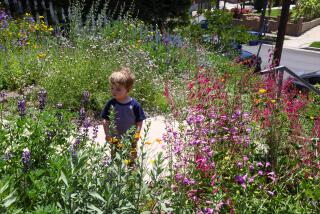June: There’s a bright side to the gloom. Plant those last blasts of summer color
- Share via
June may be famous for its gloom, but gray skies let gardeners plant the last of the summer crops and flowers.
The cooler weather also gives you more time to make sure sprinklers are working properly and that plants are mulched for the hot, dry summer ahead.
Fruit drop
Deciduous fruit trees often thin themselves by shedding excess fruit in June. This is fairly common, so don’t be alarmed. Too much fruit stresses trees and breaks branches. Follow their lead: Thin crowded fruits still on branches to give them enough room so that they won’t touch as grow. There’s usually no need to thin citrus. Put props under any heavily laden tree branch, including citrus. Use sturdy 2-by-2-inch stakes and make a saddle by nailing short pieces of 1-by-2 at the top.
If deciduous or citrus fruits split, there’s a good chance it’s caused by erratic or over watering. Don’t irrigate too often but let water soak deeply each time you do. Mound up watering basins or let hoses trickle so water can soak in to a depth of at least 18 inches.
Mulch
A proven way to save water is to mulch the soil around plants to keep them moist. The trouble is that good mulches are hard to come by. Most commercially available kinds, such as chunks of bark or simple soil amendments, are either too fine or too coarse. They allow spaces where creatures such as earwigs, sow bugs and even slugs can hide and breed, or they may not shade the soil enough, or they might simply wash away.
Partially composted garden waste makes the best mulch and residents of Los Angeles are lucky because the city gives the stuff away. There are six locations from San Pedro to the West Valley. For maps, go to www.lacity.org/san/solid_resources/pdfs/mulching_poster.pdf.Or start a compost pile to make it yourself.
Container care
Plants in containers need frequent watering in summer, sometimes twice a day. If the plants wilt often, they may need to be repotted to a larger container. Increase the size of a pot only one or two inches at a time. “Over potting” - where there is too much soil and too few roots - lets water run around the old root ball rather than to it. If there are not enough roots to absorb the moisture, the dirt stays too wet and plants rot. Fertilize every two weeks or once a month; irrigations flush fertilizers from potting soils. A few soils have slow-release fertilizers built in, so they may not need any additional feeding.
By the beach
Coastal gardeners can easily grow fuchsias and tuberous begonias for summer color. These two plants bloom best with strong light or speckled sun. They thrive in a rich, porous soil or in pots. They seem to do best with frequent fertilizing - every two weeks with something like fish emulsion or another gentle fertilizer (to avoid burning).Some fuchsias are for hanging baskets; others are more upright kinds that make little shrubs, such as the readily available, sun-tolerant ‘Gartenmeister Bonstedt.’Summer eats
Vegetable patches should be up and growing now. As space becomes available, you can still plant beans, beet, carrot, chayote, corn, cucumber, endive, melon, New Zealand spinach, onion, squash, sunflower, Swiss chard, tomato and watermelon. Leaf lettuce is another possibility, but it will need some shade inland. If you want pumpkins for Halloween, plant before June 15.
Tomatoes planted earlier in the season are getting huge, so watch for those big tomato hornworms. Green in color, they are hard to spot, but if entire branches and leaves begin to disappear, or you see their black, pellet-like droppings, search harder. Pick them off, with gloves if you are squeamish, and put them in the trash or otherwise dispose of them. Also watch for the green, triangular Keel-backed treehoppers, and their black, spiny young. They suck plant juices and can be dispatched with a squirt of soap spray, though new ones may appear within days. Stay vigilant.
Save water
Unless your plants require little irrigation, watering will be an issue this month, especially with local authorities looking for ways to conserve the precious resource. Hours for watering may be cut back. Automated sprinkler systems are best set to come on in the wee hours of the morning. But it’s a good idea to check them occasionally during daylight to make sure the sprinklers are working properly. You also may be wasting water if the nozzles have broken or if pipes are cracked or separated. Irrigate early in the morning, when water pressure is highest. Keeping soil dry at night discourages disease and slows the malicious wanderings of slugs and snails, which prefer moist ground.
Too late to plant?
Not if you’re trying to get in a little more summer color. Many plants love the sun and heat, including dahlias. These can be found at your local nursery. In the shade try coleus, mimulus and impatiens. Lobelia do fine in partial shade.






